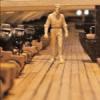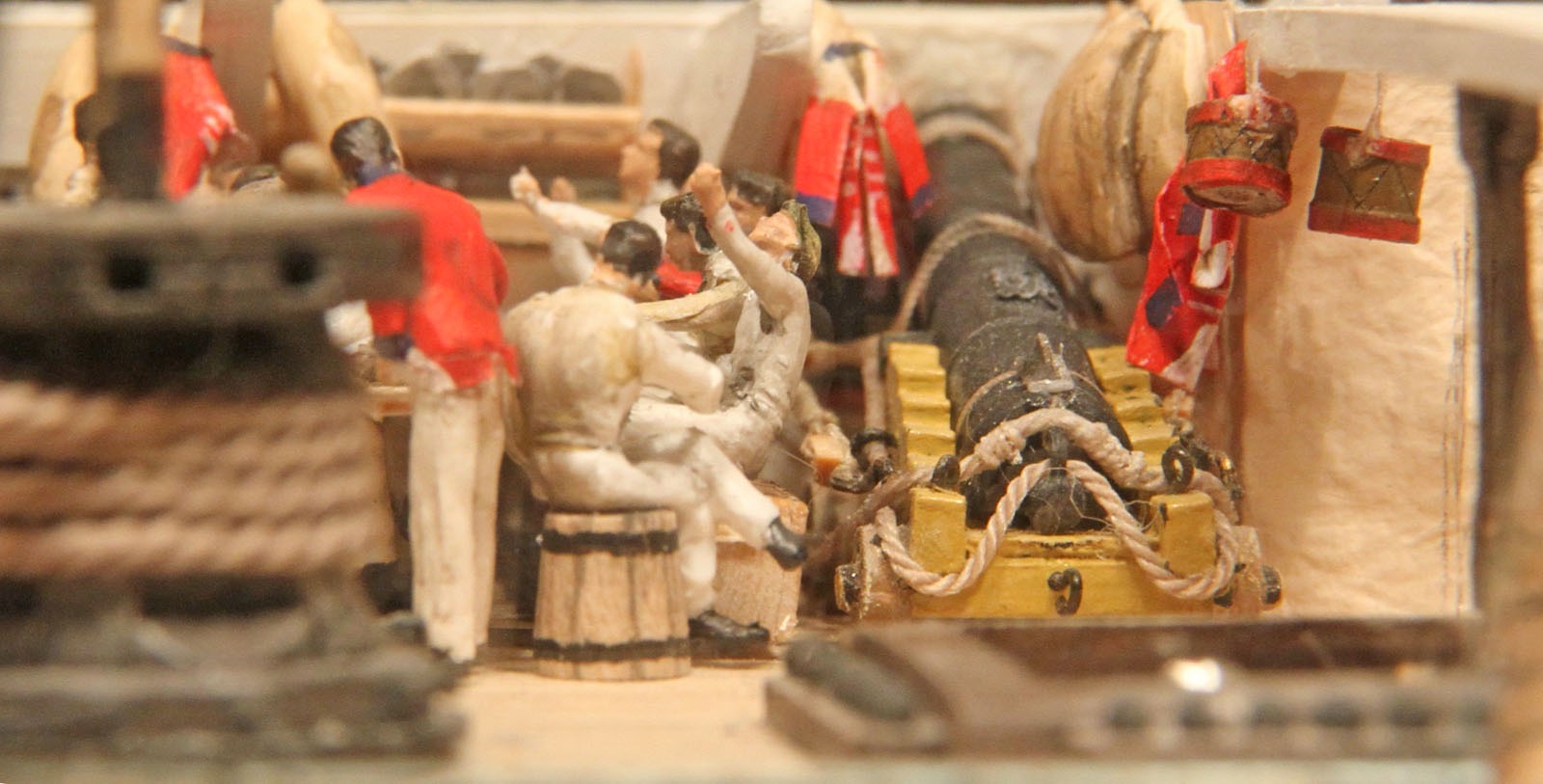-
Posts
2,416 -
Joined
-
Last visited
Content Type
Profiles
Forums
Gallery
Events
Everything posted by dafi
-
Was the size of the trays of square meals regulated? I believe it was more or less half the depth of the table and so it could be variying upon the space available? In the pictures and drawings they appear to have about 40 cm in size http://www.flickr.com/photos/58679007@N00/5700633764/in/photostream/ Thank you, Daniel Edit: Enlarged the titel as some aspects of the mess fit nicely.
-

Belaying Pins
dafi replied to allanyed's topic in Discussion for a Ship's Deck Furniture, Guns, boats and other Fittings
In this scale one could also try the method described by Reed: a short bit of wire and some white glue. As I cut of the ones provided on my build, I had to do some new ones in 1:100 ... ... some wire, put in a stand, some white glue to form a drop on the top and some paint spilt over it. All exactly 4 mm long, just standing a little bit messy in the stand. Things got stuck together - pins with rail and pins-rail-mast together with trial poop deck ... Worked very well, if the wire is not too soft, also quite stabele to rig. Daniel -

HMS Victory by Sven - FINISHED - 1:600 scale
dafi replied to Sven's topic in - Build logs for subjects built 1751 - 1800
Wonderful!!! XXXDAn -
Been there Jan, done that ... ... thats the one I had done from the parts of the box ... ... and that is how it looked like before ... ... just the little knobs missing that I cut off to get a bending template. Much more a good magnifying glass is needed :-) XXXDAn
-
It feels great to be back in the shipyard after some absence due to work and holiday. So got my building report out of page 47 and undusted it ... A friend of mine once said, it is no etch, if it doesn´t hurt, so I tried one of the last parts, with some tiny lilies ... ... but I think they still need some water to grow a tad ... :-) XXXDAn
-
Mark, you old flatterer :-) And of course I have to like this, but Willi is still far beyond :-) The only modeler I know who build a 1:1 waterline model with full rigging ... Thank you SkechupModeller. This solved one thing I was thinking long for already. Daniel
-
Thank you Mark, I was in Austria, near my favorite place in the secret austrian ship yards where I already discovered the SMS Trinkstein ... http://modelshipworld.com/index.php?/topic/349-sms-trinkstein-by-dafi-sos-stone-on-soil-flush-deck-frigate-of-the-austrian-mountain-navy/ This time I meet sone austrian forum comrades and visited the Go Modelling exhibition. Very few sailing ships, the ones shown mostely made out of paper which took me some time to discover, that perfect they were :-) Highlight were the Royal Oak in the Heeresgeschichtliches Museum Wien (Army Museum Vienna) and the York of Willi Meischel, which I had the honor to meet on his place. http://www.schifferlbauer.at/seite64.html http://www.schifferlbauer.at/seite16.html http://www.schifferlbauer.at/seite17.html http://www.schifferlbauer.at/seite18.html http://www.schifferlbauer.at/seite19.html Enjoy, Daniel
-
Hello Jan, just back from a holiday, so the answer a bit late. Thank you for your comment. Both versions base on a 0,4 mm diameter, which is near the real thing. Just the etch has a square form and so always appears a tad thicker if seen from diagonally. The lengths of the middle parts of my etch ones have still to be shortened a bit. I think no etch can beat a self- made version out of round wire on this place, but it is a question of ability and endurance and of course of convenience which version one does prefer for his own build. But it is far better than the original Heller version, which one was - has to admit - innovative and a big step forward in sailing ship model making by the time that the kit was released! Liebe Grüße, Daniel
-
As always: intriguing to watch, impeccable execution and stunning result :-) And the most important: thank you for showing your know-how!!! Liebe Grüße, Daniel
- 755 replies
-
- finished
- caldercraft
-
(and 1 more)
Tagged with:
-

A serving machine that serves you well
dafi replied to dafi's topic in Modeling tools and Workshop Equipment
Thank you Sirs, @p2s: Not shown here, but easily done when needed. :-) Daniel -
Hello Jay, looks like my earlier post didn´t make it to the front end ... These drills I use are from Proxxon/Dremmel accessories department. There are the same kind from the DIY department stores, but they are inferior quality. Daniel
-
...hihihihi... ...good night goody ... ...and the one I was most curious for: Grüßle, Daniel
-

Question about 17th century spritsail topmast
dafi replied to Ilhan Gokcay's topic in Masting, rigging and sails
Could it be said that the staysails are just going to the sprit itself but not to the topmast as this was a rather fragile construction? If a jib was used, can it be, that the topsail spar was taken down and replaced by a spar protruding to the front becoming later on the Jibboom? Daniel -
Hello Patrick, thank you. I will soon show them as the final stage is done. it is 4 A5 plates jam packed plus 2 plates with sidings :-) Daniel
-
Usually the hammock cranes are the easiest topic, the construction is quite clear out of square or round iron rods, from a certain height on with a rod holding them together on the top. The netting is already more confusing: diagonal as mostly shown or horizontal and vertical as seen in Brays drawings and some museum ships today? http://collections.rmg.co.uk/collections/objects/200823.html Also were they black or white - both versions seen on the vic over the years, the actual one is diagonal in white. The cranes were covered with tarred (?) canvas. Does this mean light brown or a deeper color? And now the most complicated. Usually (if shown) the hammocks are a small roll of tissue, bent in the middle to a "u"-shape and stored vertical. I am rather sure, that there were about 7 lachings holding it tight together and they looked like giant (dirty) white maggots :-) But were they stowed vertically? Especially on the poop decks the cranes had a very reduced height, so it would be more logical to lay them horizontally. How was it done with the higher cranes? Also horizontal or mixed directions? Could not find contemporary hints for that one yet. As usual, plenty of questions, hope they are interesting to you too, Daniel
-
Nice to have you back Evan :-) All the best, Daniel
- 446 replies
-
- Revell
- Constitution
-
(and 1 more)
Tagged with:
-
And here comes yesterdays workout program: First the easiest part the poop skylight - Still the glazing and some reinforcements on the inside have to be added. Then the different gunport lid hinges ... ... in place and beringed, both sides. The fake steering wheel columne: The rail of the poop got more exiting again. Closed the slots and cut off the nipples from the buckets ... ... flexed the new hangers of the buckets ... ... drilled the holes for the hammock cranes into the styrene ... ... and fixed the cranes and a bucket - fits :-) Even more fun was the binnacle ... ... the outside was tight part to be bent, bent the inside part, paper "flooded with thin CA" (Reed) as base for the compass layer cake, ... ... small top for the funnel formed with the center punch ... ... and with the styrine rod and the micro rings on the side it is at least an improvement towards the one of the box :-) Still missing the glazing and the lantern in the middle, this one out of a toothpick as done before. And then the heading for mishaps, missteps, and misfortune: the boarding pikes. The brass parts were ok, but first I took the wrong measures - first tear-off - then forgot that I elongated the rubbing pouch downwards - second tear-off - and then still misplaced the rings and lost the nice detail of the spearhead underneath the ring - no tear off as I did not manage - so have to live with this small mishap ... One can imagine, how the brass parts and the masts looked like ... In the meantime I managed to clean it up a tad, and the rest will disappear underneath the collar that protects the hole in the deck and the underneath the main and preventer stay. Now still have to try the chains and some other unimportant stuff :-) Lieber Gruß, Daniel
-
Thank you Sirs :-) Last cognizance was that I forgot the ciphers on the already glued in guns ... ...so I tried something new ... ... I thought ... ... and remembered, that CA does not stick on silicon. So stuck a ball of silicon on a stick and took a form of one gun with cipher. After taking off the form, I plaved a cipher inside and ... ... with some CA on the cipher I ran full risk ... ... and placed it onto the gun, and after two seconds I was able to retrieve the stick and the cipher was on place :-) Have to remember this trick :-) And just some more Cipherorama ... Enjoy, Daniel
-
Nice to see the twins again. Tasty rendering of the cages :-) Daniel
- 552 replies
-
- maine lobster boat
- Midwest Products
-
(and 1 more)
Tagged with:
-
What a nice and happy ending :-) Thanks for sharing, Daniel
- 40 replies
-
- ancre
- Chaloupe Armee En Guerre
-
(and 1 more)
Tagged with:
-
Hello Karl, nice top see this one again:-) Thank you for showing! Grüßle, Daniel
- 40 replies
-
- ancre
- Chaloupe Armee En Guerre
-
(and 1 more)
Tagged with:
About us
Modelshipworld - Advancing Ship Modeling through Research
SSL Secured
Your security is important for us so this Website is SSL-Secured
NRG Mailing Address
Nautical Research Guild
237 South Lincoln Street
Westmont IL, 60559-1917
Model Ship World ® and the MSW logo are Registered Trademarks, and belong to the Nautical Research Guild (United States Patent and Trademark Office: No. 6,929,264 & No. 6,929,274, registered Dec. 20, 2022)
Helpful Links
About the NRG
If you enjoy building ship models that are historically accurate as well as beautiful, then The Nautical Research Guild (NRG) is just right for you.
The Guild is a non-profit educational organization whose mission is to “Advance Ship Modeling Through Research”. We provide support to our members in their efforts to raise the quality of their model ships.
The Nautical Research Guild has published our world-renowned quarterly magazine, The Nautical Research Journal, since 1955. The pages of the Journal are full of articles by accomplished ship modelers who show you how they create those exquisite details on their models, and by maritime historians who show you the correct details to build. The Journal is available in both print and digital editions. Go to the NRG web site (www.thenrg.org) to download a complimentary digital copy of the Journal. The NRG also publishes plan sets, books and compilations of back issues of the Journal and the former Ships in Scale and Model Ship Builder magazines.


